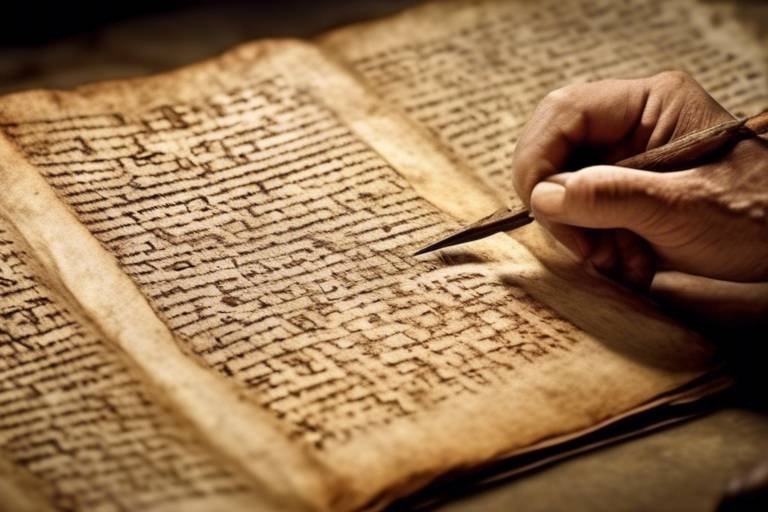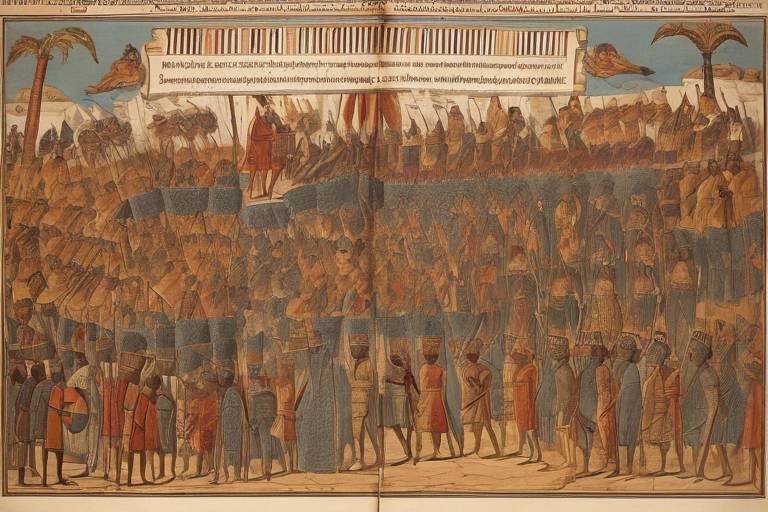The Rise and Fall of the Mughal Empire - A Historical Analysis
The Mughal Empire, a grand chapter in Indian history, witnessed a remarkable journey from its inception to its eventual decline. Founded in 1526 by Babur, a skilled warrior with a lineage tracing back to Timur and Genghis Khan, the empire's establishment marked a significant turning point after the decisive Battle of Panipat. Babur's triumph heralded the dawn of a new era under the Mughal dynasty, setting the stage for centuries of power and influence in the Indian subcontinent.
Throughout its storied history, the Mughal Empire saw the rise of key rulers who left an indelible mark on the empire's legacy. Figures like Akbar the Great, known for his progressive policies and religious tolerance, Jahangir, a patron of the arts, and Shah Jahan, famed for architectural wonders like the Taj Mahal, each contributed to the empire's flourishing cultural landscape and territorial expansion. Their reigns were characterized by a blend of military prowess, administrative acumen, and a deep appreciation for the arts.
The cultural achievements of the Mughal Empire are a testament to its enduring legacy. From the majestic structures like the Red Fort in Delhi to the intricate beauty of miniature paintings, the Mughals excelled in art, architecture, literature, and music. The fusion of Persian and Indian styles gave rise to a unique aesthetic that continues to captivate admirers worldwide. Urdu poetry flourished, reflecting the rich cultural tapestry woven by the Mughal rulers and their subjects.
However, the empire's decline was inevitable, marred by internal conflicts, economic instability, and the encroachment of foreign powers. Weak successors and invasions by the British East India Company hastened the erosion of Mughal authority, leading to a gradual unraveling of the once-mighty empire. Despite valiant efforts to resist external pressures, the empire's downfall became a poignant chapter in Indian history, signaling the end of an era.
Despite its waning influence, the Mughal Empire's impact on the Indian subcontinent endures to this day. The imprint of Mughal culture can be seen in language, cuisine, customs, and traditions that have withstood the test of time. Architectural marvels like the Taj Mahal stand as timeless tributes to the empire's grandeur, while artistic achievements continue to inspire generations of creators and scholars.
In modern India, the legacy of the Mughal Empire remains palpable, shaping contemporary society in myriad ways. Historical sites meticulously preserved, culinary traditions passed down through generations, and the enduring allure of Mughal-inspired art and architecture all bear witness to the empire's enduring influence. The Mughals' vision and creativity continue to resonate in the vibrant tapestry of Indian culture, a testament to their lasting impact on the nation's heritage.
The historical significance of the Mughal Empire transcends mere chronicles of conquest and decline. Its rise and fall have left an indelible mark on the fabric of Indian history, influencing political structures, cultural practices, and societal norms that endure to this day. The legacy of the Mughal Empire serves as a poignant reminder of the ebb and flow of empires, their enduring legacies, and the intricate interplay of power and culture in shaping the course of nations.

Establishment of the Mughal Empire
Founded in 1526 after the Battle of Panipat by Babur, a descendant of Timur and Genghis Khan, the Mughal Empire marked the beginning of a significant era in Indian history. Babur's victory paved the way for the establishment of a dynasty that would shape the subcontinent for centuries to come.
The Mughal Empire's inception under Babur's leadership signified a turning point in Indian history. With a lineage tracing back to powerful conquerors, Babur's triumph at Panipat solidified his rule and laid the foundation for a dynasty that would leave an indelible mark on the Indian subcontinent.

Key Rulers of the Mughal Empire
Establishment of the Mughal Empire
The Mughal Empire, a monumental chapter in Indian history, traces its origins back to 1526 when Babur, a descendant of Timur and Genghis Khan, established the empire after the pivotal Battle of Panipat. This marked the dawn of a new era under the Mughal dynasty, bringing forth an amalgamation of cultures and traditions.
Throughout its illustrious reign, the Mughal Empire witnessed the leadership of remarkable rulers who left an indelible mark on history. Akbar the Great, known for his visionary policies of religious tolerance and administrative reforms, stands out as a pivotal figure. His successors, including Jahangir, renowned for his patronage of arts, and Shah Jahan, the visionary behind the iconic Taj Mahal, further solidified the empire's grandeur.
These rulers not only expanded the empire's territorial reach but also nurtured a flourishing cultural landscape that blended diverse influences. Their reigns were characterized by a harmonious coexistence of different faiths and a patronage of arts and architecture that defined the golden age of the Mughal Empire.
Moreover, the Mughal rulers' strategic alliances and diplomatic acumen played a crucial role in maintaining stability and prosperity within the empire, fostering an environment conducive to artistic and intellectual pursuits.
While each ruler brought their unique contributions to the empire, collectively, they propelled the Mughal Empire to unparalleled heights of cultural and political splendor, leaving a legacy that continues to captivate historians and enthusiasts alike.

Cultural Achievements of the Mughal Empire
The Mughal Empire, known for its rich cultural heritage, made significant contributions to various artistic and intellectual fields, leaving a lasting impact on Indian history. One of the most iconic cultural achievements of the Mughal era is the construction of the majestic Taj Mahal by Emperor Shah Jahan in memory of his beloved wife Mumtaz Mahal. This architectural masterpiece, with its intricate marble work and symmetrical design, stands as a symbol of eternal love and artistic excellence.
In addition to architectural marvels, the Mughals were patrons of the arts, particularly miniature paintings. These intricate artworks depicted scenes from court life, nature, and mythology with exquisite detail and vibrant colors, showcasing the artistic prowess of Mughal painters. The fusion of Persian and Indian artistic styles in these paintings created a unique visual language that continues to inspire artists to this day.
Urdu poetry flourished under the Mughal Empire, with poets like Mirza Ghalib and Bahadur Shah Zafar composing verses that captured the complexities of human emotions and the beauty of nature. Urdu, a language that evolved as a result of the mingling of Persian and local dialects during the Mughal period, became a medium of expression for poets, scholars, and common people alike.
The Mughals also made significant contributions to music, with the development of classical Indian music traditions. Emperors like Akbar the Great were known for their patronage of musicians and the creation of new musical forms. The fusion of Indian ragas with Persian melodies led to the emergence of unique musical styles that enriched the cultural landscape of the empire.

Factors Contributing to the Decline of the Mughal Empire
The decline of the once-mighty Mughal Empire was a complex process influenced by various factors that gradually weakened its foundations. Internal strife among the ruling elite and the lack of strong leadership after the reign of Aurangzeb paved the way for external threats and internal disintegration. The economic challenges faced by the empire, including revenue collection issues and inflation, further exacerbated its decline. Additionally, the emergence of regional powers and the increasing influence of European colonial powers, such as the British East India Company, posed significant challenges to Mughal authority and control.
One of the critical factors contributing to the downfall of the Mughal Empire was the succession of weak rulers who were unable to maintain the stability and unity of the vast empire. Incompetent and divisive successors weakened the central authority, leading to power struggles and factionalism within the empire. This internal turmoil created opportunities for external powers to exploit the weakening Mughal state, further accelerating its decline.
The invasions and incursions by foreign powers, particularly the British East India Company, played a pivotal role in dismantling the remnants of Mughal power. The Company's aggressive expansionist policies, military conquests, and economic exploitation gradually eroded the Mughal Empire's territorial control and resources. The Battle of Plassey in 1757 and the subsequent annexation of Bengal marked the beginning of British dominance in India, signaling the end of Mughal sovereignty over vast territories.

Impact of the Mughal Empire on the Indian Subcontinent
Topics to be discussed in the article include the establishment of the Mughal Empire, key rulers, cultural achievements, decline factors, and the lasting impact on the Indian subcontinent.
When exploring the impact of the Mughal Empire on the Indian subcontinent, one cannot overlook the profound influence it had on various aspects of Indian society. From language to architecture, the Mughals left an indelible mark that continues to shape the cultural landscape of the region.
The fusion of Persian and Indian styles in art and architecture exemplifies the rich cultural tapestry woven by the Mughals. The iconic Taj Mahal stands as a testament to their architectural prowess, blending intricate designs with symbolic meaning.
Furthermore, the Mughal Empire's patronage of Urdu poetry and miniature paintings contributed to the flourishing of artistic expression. These artistic forms not only reflected the beauty of the era but also served as a means of storytelling and cultural preservation.
On a culinary level, the Mughals introduced new flavors and cooking techniques that continue to influence Indian cuisine to this day. The use of aromatic spices and elaborate dishes became synonymous with Mughal dining traditions, shaping the gastronomic heritage of the subcontinent.
In terms of customs and traditions, the Mughal Empire's legacy can be seen in various rituals and practices that have been passed down through generations. From intricate embroidery patterns to festive celebrations, the Mughals infused their unique flair into the fabric of Indian culture.
Overall, the impact of the Mughal Empire on the Indian subcontinent transcends mere historical significance; it is a living legacy that resonates in the arts, cuisine, and customs of modern-day India.

Legacy of the Mughal Empire in Modern India
The Mughal Empire, one of the most powerful dynasties in Indian history, has left an indelible mark on the Indian subcontinent. Established in 1526 by Babur, a descendant of Timur and Genghis Khan, the empire's roots run deep, shaping the course of Indian history for centuries to come.
Even in modern India, the echoes of the Mughal Empire can be heard and seen in various aspects of society. The architectural wonders left behind by the Mughals, such as the majestic Taj Mahal, stand as a testament to their grandeur and artistic prowess. These structures not only serve as tourist attractions but also as a reminder of a bygone era of opulence and architectural brilliance.
The Mughal Empire's influence extends beyond mere monuments; it has seeped into the very fabric of Indian culture. The fusion of Persian and Indian styles in art and architecture, a hallmark of the Mughal era, continues to inspire contemporary artists and architects. The intricate miniature paintings and Urdu poetry that flourished under Mughal patronage still captivate audiences with their beauty and depth.
Moreover, the culinary traditions of modern India bear the imprint of the Mughals, with dishes like biryani and kebabs tracing their origins back to the royal kitchens of the Mughal emperors. The flavors and aromas that define Mughal cuisine have become an integral part of Indian gastronomy, delighting taste buds across the country.
Furthermore, the Mughal Empire's emphasis on cultural diversity and religious tolerance has had a lasting impact on Indian society. The promotion of harmony among different faiths during the Mughal era laid the foundation for India's secular ethos, fostering a spirit of inclusivity and acceptance that endures to this day.
In conclusion, the legacy of the Mughal Empire in modern India is not just a relic of the past but a living, breathing influence that continues to shape the cultural landscape of the country. From architecture to cuisine, from art to social harmony, the Mughals' imprint can be felt in every corner of India, a testament to their enduring legacy.

Historical Significance of the Mughal Empire
The Mughal Empire holds immense historical significance that reverberates through the annals of Indian history. Its establishment in 1526 by Babur marked a pivotal moment that shaped the political landscape of the Indian subcontinent for centuries to come. The Mughals, with their rich cultural heritage and architectural marvels, not only left a lasting impact on India but also influenced the socio-political fabric of the region.
One of the key aspects of the Mughal Empire's historical significance lies in its role as a unifying force. Under the rule of emperors like Akbar the Great, the empire saw a period of religious tolerance and cultural syncretism. This era of inclusivity and diversity laid the foundation for a pluralistic society that continues to define India's identity today.
Furthermore, the Mughal Empire's architectural legacy, epitomized by iconic structures like the Taj Mahal and the Red Fort, showcases the grandeur and sophistication of Mughal artistry. These monuments not only stand as testaments to the empire's opulence but also serve as reminders of India's rich cultural heritage.
Moreover, the Mughal Empire's administrative innovations, such as the establishment of a centralized bureaucracy and a uniform system of governance, set precedents that influenced subsequent rulers and administrations in the region. The empire's emphasis on efficient governance and revenue collection mechanisms left a lasting imprint on the administrative practices of India.
Additionally, the Mughal Empire's patronage of arts and literature led to a flourishing cultural renaissance. The fusion of Persian and Indian artistic traditions, exemplified in miniature paintings and Urdu poetry, created a vibrant cultural tapestry that continues to inspire artists and scholars to this day.
In conclusion, the historical significance of the Mughal Empire transcends mere chronicles of conquests and defeats. It symbolizes a golden era of cultural exchange, artistic brilliance, and administrative innovation that continues to shape the collective memory of the Indian subcontinent.
Frequently Asked Questions
- What was the significance of the Battle of Panipat in the establishment of the Mughal Empire?
The Battle of Panipat in 1526 marked a turning point in Indian history as Babur's victory established the foundation of the Mughal Empire. It paved the way for Babur to become the first Mughal emperor in India.
- How did Akbar the Great contribute to the cultural achievements of the Mughal Empire?
Akbar the Great was known for his promotion of religious tolerance, patronage of the arts, and architectural innovations. His reign saw the flourishing of Mughal culture through the fusion of Persian, Indian, and Central Asian influences.
- What factors led to the decline of the Mughal Empire?
The decline of the Mughal Empire was influenced by internal conflicts, economic instability, ineffective leadership of successors, and invasions by foreign powers. These factors weakened the empire over time, leading to its eventual downfall.
- How did the Mughal Empire impact modern Indian society?
The Mughal Empire's legacy can be seen in various aspects of modern Indian culture, including architecture, cuisine, language, and traditions. The empire's influence continues to shape contemporary India's cultural identity and heritage.



















